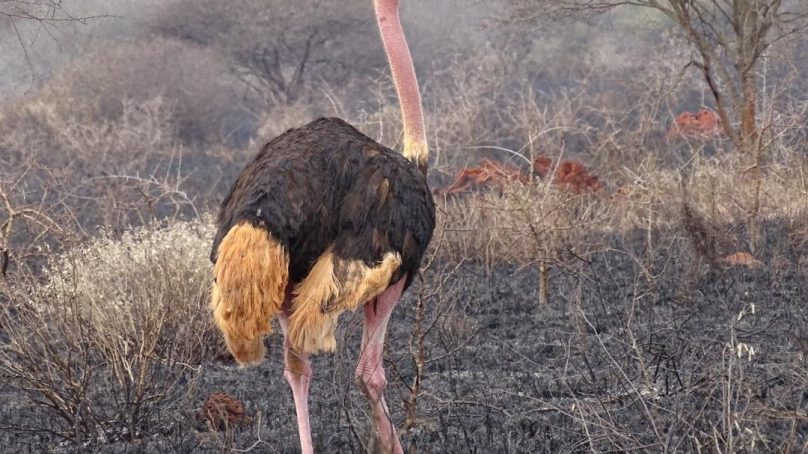
As Kenya faces a rising threat of wildfires in protected and unprotected areas, researchers and fire management experts are calling for a radical shift from reactive to proactive approaches, with indigenous knowledge at the centre of the solution.
Speaking during an integrated fire management workshop in Taita Taveta County, senior lecturer and fire modeller in department of geography at King’s College London and member of the Leverhulme Centre for Wildfires, Environment and Society James Millington, pointed out that not all fire is bad. Instead, he argued, fire is a natural part of many ecosystems and can be beneficial when properly managed.
“While we’ve seen devastating wildfires like the one in Los Angeles in January 2025 that destroyed homes and claimed lives, fire also plays a crucial role in ecosystems. It promotes forage for livestock, clears agricultural waste, and enables vegetation to regrow,” Millington said.
The workshop, which was the first in a series aimed at developing an integrated fire management plan for Tsavo ecosystem, brought together local communities, county officials and NGOs.
Its goal is to reframe how fire is perceived and managed by shifting away from outright suppression to a more balanced approach that distinguishes between harmful wildfires and beneficial, controlled burns.
Millington noted that years of fire suppression have ironically increased the risk of uncontrollable blazes. He said: “When vegetation is left to build up, a single spark can lead to a massive, destructive fire. Controlled burns can reduce this risk.”
The researcher cited northern Australia as a model where indigenous knowledge is now being reintegrated into fire management. There, cultural burning, which is the practice of setting low-intensity fires in a controlled manner, has helped reduce large-scale wildfires while maintaining biodiversity and supporting traditional ways of life.
“This approach could be adapted for African savannahs, including in Kenya, although we must tailor it to local contexts,” Millington added.
A resident of Taita Taveta County and participant at the workshop Philip Mwang’ombe concurs. Mwang’ombe underlined the traditional understanding and practices that local communities have used for decades to deal with wildfires.
“Most fire outbreaks here occur when people cut down trees for charcoal or when farmers uses fire to prepare land planting. The fire spreads into wildlife areas. Sometimes, wildfires are even caused by electrical faults when large birds land on power lines and cause sparks,” Mwang’ombe explained.
He observed that the intensity of wildfires is highly dependent on the amount of vegetation cover, noting that the more grass and bush present, the more intense the fire.
However, he also pointed out that fire has both benefits and risks.
“Fire kills pathogens that affect livestock, and also helps clear invasive vegetation that prevents the growth of beneficial grasses for wild animals,” he said adding that, “We have now come to understand that fire is not always bad, it depends on how it is managed.”
Mwang’ombe detailed community strategies for controlling fire, including the use of flappers, firebreaks cut using tractors, and back-burning which involves intentionally setting a controlled fire ahead of a wildfire to stop its spread.
He stressed that for indigenous fire knowledge to be truly effective, local communities must be involved in decision-making, especially those who are directly affected by the fires.
“Government support is also crucial. There are moments when community efforts alone cannot manage big fires, and that’s when government resources come in handy,” he added.
Tabitha Mnjala, a resident of Kasigau and a warden at Kasigau Wildlife Conservancy, supported the idea of controlled burning. She said such practices help kill ticks and other harmful insects in the grasslands, threats that often go unnoticed until wild animals start dying.
“We see it happen during our daily patrols. If not controlled, these insects can seriously impact wildlife populations. Controlled fires help not only regenerate vegetation but also safeguard the health of animals in the conservancies and nearby ranches,” Mnjala explained.
She stressed that controlling the fire’s spread is essential, both to avoid unintended consequences and to ensure safety for the neighbouring human populations. She affirmed that controlled burns, when well-managed, are key to ecosystem restoration and biodiversity protection.
A Kenyan PhD research student also based at King’s College London Chege Amos, is leading a study on wildfires across Kenya’s protected and unprotected areas. His project seeks to document historical trends of wildfires and incorporate indigenous knowledge into national fire management frameworks.
“Colonial-era fire policies disrupted traditional fire management systems, side-lining community knowledge that had maintained balance in ecosystems for generations. We are now working to rebuild that connection by involving communities from the ground up,” Chege said.
Chege emphasized that fire, from an ecological and social perspective, holds significant benefits right from controlling pests and improving soil quality to regenerating fresh vegetation for grazing. However, he lamented that Kenya’s current fire management approach remains largely reactive, with most responses coming after wildfires have already caused damage.
“Our policies focus heavily on fire suppression, but not on planning ahead. We spend millions reacting to fires when proactive management could save lives, ecosystems, and resources,” he noted.
A key outcome of the workshop is the push for the development and adoption of Integrated Fire Management (IFM) plans. These plans combine scientific approaches with indigenous knowledge and cultural practices to create sustainable, inclusive strategies for managing fire.
Chege called for revisions to Kenya’s fire-related legislation, noting that current laws lack clarity and fail to address the complexities of fire use in conservancies, ranches, and community lands outside national parks.
“The bill under review only penalizes fires set in protected areas, ignoring other equally vulnerable landscapes. We propose expanding its scope and introducing clear guidelines on permits, the timing and location of prescribed burns, and responsible fire use,” he said.
Both Chege and Millington acknowledged the importance of inclusive stakeholder involvement in developing fire management policies. From ranchers and farmers to county and national government officials, they called for a collaborative approach to tackle the growing threat of wildfires.
“This is a process. This first workshop is just the beginning. We plan to continue engaging with communities and stakeholders in future sessions and, by the end of the year, develop a draft plan that supports both human livelihoods and wildlife conservation,” Chege said.
Tsavo landscape, which includes large conservation areas and adjacent pastoral and agricultural lands, has witnessed fire incidents over the years. The adoption of a well-planned, inclusive fire management strategy could not only safeguard biodiversity but also enhance climate resilience and reduce the economic burden of wildfire responses.
- A Tell Media / KNA report / By Arnold Linga Masila
An ostrich left stranded for both food and shelter after a devastating wild infern








